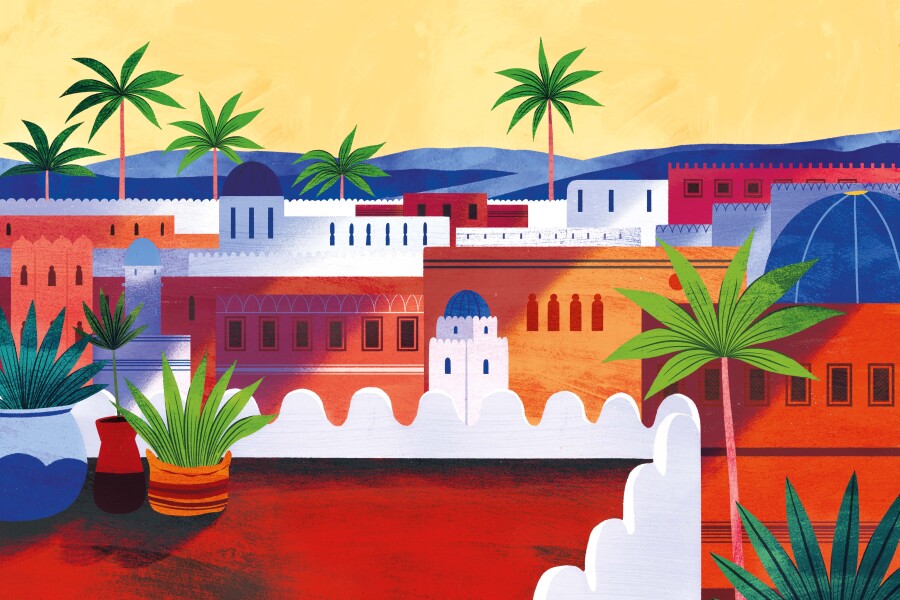The light is distinctive in Tangier. At dawn, it pierces through the early morning mist; at midday, it splinters into shafts of light; the golden sunset transforms everything into glowing embers; and at night, silver studs punctuate the deep velvet sky. Just before sunrise, the call to morning prayer echoes from numerous towers across the city, rising in volume before darkness melts into day.
Tangier sits on the northernmost tip of Africa, overlooking both the inky Mediterranean Sea and the azure Atlantic Ocean. Not far away is the Strait of Gibraltar, and these geographical cross-currents result in a synergy of nationalities and languages, mainly French, Arabic and English. Blending these influences and its unique location, Tangier is Europe’s gateway to Africa. For a time, it was semi-independent from Africa as an international zone, which attracted diplomats, artists, writers and holiday-makers. After the 1950s, its popularity dipped, but its charm is once again rising. Now you can appreciate anew the same sights that attracted French artists Eugène Delacroix in 1832 and Henri Matisse in 1912 and 1913.

Most of Matisse’s Tangier paintings feature vivid pinks, yellows, blues and greens, circles, stripes and other shapes, all created with thin washes of pigment.
Illustrations by Amy Grimes
In the early 20th century, Tangier attracted the avant-garde Fauve painter Henri Matisse (1869–1954), seeking a new direction for his art. He was charmed by the cosmopolitan city, its bright and luminous light, vivid colours, variegated sunshine and striking, exotic architecture. With his ardent appreciation of Persian art, and his admiration of Delacroix’s North African paintings, as well as advice on colour that he was given by Paul Gauguin, Matisse was delighted with his visits to the city and they had a profound effect on his work and career. He described the light of Tangier as “mellow” and the city as “a painter’s paradise,” and he interpreted it all with rich pigments, animated brushwork and contrasting patterns. The landscapes of Tangier were far more luxuriant than any he had seen before. On his arrival, he went almost immediately into the gardens of the Villa Brooks, a private estate not far from his hotel, and spent weeks painting the acanthuses, palms and periwinkles that grew there.
While in Tangier, Matisse produced approximately 20 oil paintings and even more sketches, using bold shapes and vibrant, expressive colours. On his arrival in the city, it was raining, and he painted a vase of irises in his hotel room, emphasising the pattern created by the flowers against the dressing table and mirror, but among his most evocative paintings of Tangier are his 1912 landscapes Vue sur la Baie de Tangier (View of the Bay of Tangier) and La Porte de la Casbah (Entrance to the Kasbah), and Paysage Vu d’une Fenêtre (Landscape Viewed from a Window) of 1913. Mainly captured in brilliant blue, evoking the reflection of the sky on the stark white buildings, this last image was painted directly from his window in Room 35 of the Grand Hôtel Villa de France, looking out over St. Andrew’s Church to the kasbah beyond.
Most of Matisse’s Tangier paintings feature vivid pinks, yellows, blues and greens, circles, stripes and other shapes, all created with thin washes of pigment. Although he spent only a few months there, the experiences and inspiration remained with Matisse for the rest of his life and completely shaped his subsequent art. Later in the 1920s, his paintings of odalisques that he produced in Nice, of reclining females set against patterned cushions, wallpaper and carpets, are clearly the direct result of the way in which the magical light of Tangier affected him.
Reprinted with permission from Artistic Places by Susie Hodge, with illustrations by Amy Grimes. Artistic Places is published by White Lion Publishing and is on sale May 17, 2021.
Buy Now: $20, amazon.com
>> Next: A New Mother Finds Comfort on a Solo Trip to Morocco











